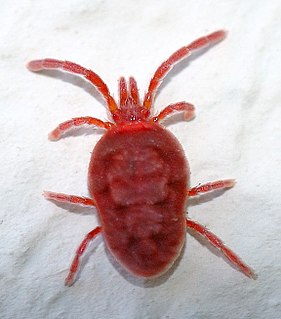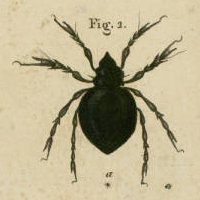
Ticks are small arachnids, typically 3 to 5 mm long, part of the order Parasitiformes. Along with mites, they constitute the subclass Acari. Ticks are ectoparasites, living by feeding on the blood of mammals, birds, and sometimes reptiles and amphibians. Ticks had evolved by the Cretaceous period, the most common form of fossilisation being immersed in amber. Ticks are widely distributed around the world, especially in warm, humid climates.

Spider mites are members of the Acari (mite) family Tetranychidae, which includes about 1,200 species. They generally live on the undersides of leaves of plants, where they may spin protective silk webs, and they can cause damage by puncturing the plant cells to feed. Spider mites are known to feed on several hundred species of plants.

Mange is a type of skin disease caused by parasitic mites. Because mites also infect plants, birds, and reptiles, the term "mange", suggesting poor condition of the hairy coat due to the infection, is sometimes reserved only for pathological mite-infestation of nonhuman mammals. Thus, mange includes mite-associated skin disease in domestic animals, in livestock, and in wild animals. Since mites belong to the arachnid subclass Acari, another term for mite infestation is acariasis.

Varroa destructor is an external parasitic mite that attacks the honey bees Apis cerana and Apis mellifera. The disease caused by the mites is called varroosis.

Varroa is a genus of parasitic mites associated with honey bees, placed in its own family, Varroidae. The genus was named for Marcus Terentius Varro, a Roman scholar and beekeeper. The condition of a honeybee colony being infested with Varroa mites is called varroosis.
Acariasis is an infestation with mites.

The Acariformes, also known as the Actinotrichida, are the more diverse of the two superorders of mites. Over 32,000 described species are found in 351 families, and an estimated total of 440,000 to 929,000 species occur, including undescribed species.

Parasitiformes is an order of Acari. An alternative name is Anactinotrichida. Parasitiformes is one of two groups (orders) in Acari, the other being Acariformes (Actinotrichida).

Opilioacariformes is the smallest order of mites, containing a single family, and around 10 genera. They are rare, large mites, and are widely considered primitive, as they retain six pairs of eyes, and abdominal segmentation. Opilioacariformes may be the sister group to the Parasitiformes.
The Phytoseiidae are a family of mites which feed on thrips and other mite species. They are often used as a biological control agent for managing mite pests. Because of their usefulness as biological control agents, interest in phytoseiids has steadily increased over the past century. In 1950, there were 34 known species. Today, there are 2,731 documented species.

The buffy flower bat is a species of bat in the leaf-nosed bat family, Phyllostomidae. It is found in the Bahamas, the Cayman Islands, Cuba, and Jamaica.

Raoiella indica, commonly known as the red palm mite, is a species of mite belonging to the family Tenuipalpidae. A pest of several species of palm in the Middle East and South East Asia, it is now becoming established throughout the Caribbean. The invasion of this species is the biggest mite explosion ever observed in the Americas.
Parasitidae is a family of predatory mites in the order Mesostigmata that has worldwide distribution. They are the only family in the superfamily Parasitoidea. Relatively large for mites, their color is often yellowish to dark brown. The family as a whole preys on a wide variety of microarthropods and nematodes, with individual species usually having a narrower range of prey. The family contains two subfamilies, 29 genera, and around 400 species.

Lorryia formosa, commonly known as the yellow mite or the citrus yellow mite, is a species of acariform mite. They are in the subfamily Tydeinae of the family Tydeidae. Commonly found on the foliage of citrus trees around the world, Lorryia formosa also associates with a variety of other plant types. The life cycle includes six discrete stages of development, and the lifespan averages about 37 days. The females of the species use an asexual form of reproduction where the growth and development of embryos occurs without fertilization by a male, a process called thelytoky.
Galumna pseudokhoii is a species of mite first found in Cát Tiên National Park, Vietnam, in dark loam in a Lagerstroemia forest. This species is very similar in the location and morphology of notogastral areae porosae, rostral morphology, lamellar and interlamellar setae, lamellar lines locations, and incomplete dorsosejugal suture to Galumna khoii, differing in body size, sensilli morphology, and the number of genital setae on the anterior parts of its genital plates.

Damaeidae Berlese (1896) is a family of mites. Alternative names for the family include Belbidae Willmann (1931), and Belbodamaeidae Bulanova-Zachvatkina (1967) or Hungarobelbidae (1996). They had been previously considered to be distinct families.

Arrenurus is a genus of water mites within the family Arrenuridae, and was first described by Antoine Louis Dugès in 1834. It has a cosmopolitan distribution in lentic waters, even on remote Pacific islands, and is found on every continent, with the possible exception of Antarctica. Some 950 species are currently recognised, making Arrenurus the largest of genera.















